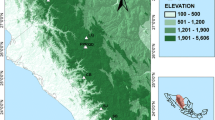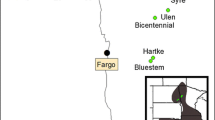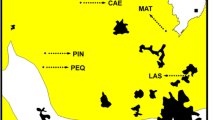Abstract
Small populations are prone to genetic drift as a consequence of random sampling effects. We investigated whether we could detect such random sampling effects in the English yew (Taxus baccata), a dioecious conifer species occurring in scattered populations in Switzerland. Seven pairs of small and large populations were analyzed using random amplified polymorphic DNA (RAPD) marker bands from 20 individuals per population. Several genetic parameters (mean marker band frequency deviation, molecular variance, population differentiation) indicated that small populations experienced genetic drift. These genetic differences between small and large populations of yew were paralleled by an increased sex ratio bias towards a higher number of females in the small populations. Our findings support earlier assumptions that the Swiss occurrences of yew may be described as metapopulation dynamics, characterized by local colonization and extinction events leading to the observed genetic drift.
Similar content being viewed by others
References
Ainsworth C (2000) Boys and girls come out to play: The molecular biology of dioecious plants. Ann. Bot., 86, 211–221.
Allnutt TR, Newton AC, Premoli A, Lara A (2003) Genetic variation in the threatened South American conifer Pilgerodendron uviferum (Cupressaceae), detected using RAPD markers. Biol. Conserv., 114, 245–253.
Barengo N, Rudow A, Schwab P (eds.) (2001) Förderung seltener Baumarten auf der Schweizer Alpennordseite BUWAL/ETHZ, Bern.
Charlesworth D (2002) Plant sex determination and sex chromosomes. Heredity, 88, 94–101.
Delph LF (1999) Sexual dimorphism in life history. In: Gender and Sexual Dimorphism in Flowering Plants (eds. Geber MA, Dawson TE, Delph LF), pp. 149–173. Springer, Berlin, Heidelberg.
DiFazio SP, Vance NC, Wilson MV (1996) Variation in sex expression of Taxus brevifolia in western Oregon. Can. J. Bot., 74, 1943–1946.
Ellenberg H (1988) Vegetation Ecology of Central Europe. Cambridge University Press, Cambridge.
Ellstrand NC, Elam DR (1993) Population genetic consequences of small population size: Implications for plant conservation. Annu. Rev. Ecol. Syst., 24, 217–242.
Excoffier L (1993) Win Amova. Analysis of Molecular Variance. Genetics and Biometry Laboratory, University of Geneva, Geneva.
Excoffier L, Smouse PE, Quattro JM (1992) Analysis of molecular variance inferred from metric distances among DNA haplotypes: Application to human mitochondrial DNA restriction data. Genetics, 131, 479–491.
Fischer M, Matthies D (1998) RAPD variation in relation to population size and plant performance in the rare Gentianella germanica (Gentianaceae). Am. J. Bot., 85, 811–819.
Frankham R, Ballou JD, Briscoe DA (2002) Introduction to Conservation Genetics. Cambridge University Press, Cambridge.
García D, Zamora R, Hódar JA, Gómez JM, Castro J (2000) Yew (Taxus baccata L.) regeneration is facilitated by fleshy-fruited shrubs in Mediterranean environments. Biol. Conserv., 95, 31–38.
Godoy JA, Jordano P (2001) Seed dispersal by animals: Exact identification of source trees with endocarp DNA microsatellites. Mol. Ecol., 10, 2275–2283.
Haldane JBS (1922) Sex-ratio and unisexual sterility in hybrid animals. J. Genet., 12, 101–109.
Hamrick JL, Godt MJW (1996) Effects of life history traits on genetic diversity in plant species. Philos. Trans. Roy. Soc. Lond. B, 351, 1291–1298.
Hartl DL, Clark AG (1997) Principles of Population Genetics. 3rd edn. Sinauer Associates, Sunderland.
Hoebee SE, Young AG (2001) Low neighbourhood size and high interpopulation differentiation in the endangered shrub Grevillea iaspicula McGill (Proteaceae). Heredity, 86, 489–496.
Holderegger R (1997) Recent perspectives in conservation biology of rare plants. Bull. Geobot. Inst. ETH, 63, 109–116.
Huenneke LF (1991) Ecological implications of genetic variation in plant populations. In: Genetics and Conservation of Rare Plants (eds. Falk DA, Holsinger KE), pp. 31–44. Oxford University Press, Oxford.
Korpelainen H (2002) A genetic method of resolve gender complements investigations on sex ratios in Rumex acetosa. Mol. Ecol., 11, 2151–2156.
Landergott U, Holderegger R, Kozlowski G, Schneller JJ (2001) Historical bottlenecks decrease genetic diversity in natural populations of Dryopteris cristata. Heredity, 87, 344–355.
Levin DA (1995) Metapopulation: An arena for local speciation. J. Evol. Biol., 8, 635–644.
Lienert J, Fischer M, Schneller JJ, Diemer M (2002) Isozyme variability of the wetland specialist Swertia perennis (Gentianaceae) in relation to habitat size, isolation, and plant fitness. Amer. J. Bot., 89, 801–811.
Mátyás G, Sperisen C (2001) Chloroplast DNA polymorphisms provide evidence for postglacial recolonisation of oaks (Quercus spp.) across the Swiss Alps. Theor. Appl. Genet., 102, 12–20.
Miller R, Campling J (2002) SPSS for Social Scientists. Palgrave, Basingstoke.
Nei M, Maruyama T, Charkaborty R (1975) The bottleneck effect and genetic variability in populations. Evolution, 29, 1–10.
Oddou-Muratorio S, Petit RJ, Le-Guerroué B, Guesnet D, Demesure B (2001) Pollen-versus seed-mediated gene flow in a scattered forest tree species. Evolution, 55, 1123–1135.
Ortiz PL, Arista M, Talavera S (2002) Sex ratio and reproductive effort in the dioecious Juniperus communis subsp. alpina (Suter) Celak. (Cupressaceae) along an altitudinal gradient. Ann. Bot., 89, 205–211.
Paule L, Gömöry D, Longauer R (1993) Present distribution and ecological conditions of the English yew (Taxus baccata L.) in Europe. In: Proceedings of Yew (Taxus) Conservation Biology and Interaction (eds. Scher S, Shimon Schwarzschild B), Berkley, pp. 189-196.
Pridnya MV (1984) Phytocenotic status and structure of the Khosta common-yew population in the Caucasus Biosphere Reserve. Soviet J. Ecol., 15, 1–6.
Rajewski M, Lange S, Hattemer HH (2000) Reproduktion bei der Generhaltung seltener Baumarten-das Beispiel der Eibe (Taxus baccata L.). For. Snow Landsc. Res., 75, 251–266.
Richards AJ (1997) Plant Breeding Systems. 2nd edn. Chapman & Hall, London.
Schmidt K, Jensen K (2000) Genetic structure and AFLP variation of remnant populations in the rare plant Pedicularis palustris (Scrophulariaceae) and its relation to population size and reproductive components. Amer. J. Bot., 87, 678–689.
Senneville S, Beaulieu J, Daoust G, Deslavriers M, Bousquet J (2001) Evidence for low genetic diversity and metapopulation structure in Canada yew (Taxus canadensis): considerations for conservation. Can. J. For. Res., 31, 110–116.
SPSS (2000) SyStat. SPSS Inc., Chicago.
Stehlik I, Blattner FR (in press) Sex-specific SCAR markers in the dioecious plant Rumex nivalis (Polygonaceae) and implications for the evolution of sex chromosomes. Theor. Appl. Genet.
Svenning J-C, Magård E (1999) Population ecology and conservation status of the last natural population of English yew Taxus baccata in Denmark. Biol. Conserv., 88, 173–182.
Thomas PA, Polwart A (2003) Biological flora of the British Isles: Taxus baccata L. J. Ecol., 91, 489–524.
Vasiliauskas SA, Aarssen LW (1992) Sex-ratio and neighbor effects in monospecific stands of Juniperus virginiana. Ecology, 73, 622–632.
Young AG, Boyle TJ (2000) Forest fragmentation. In: Forest Conservation Genetics (eds. Young AG, Boshier D, Boyle T), pp. 123–134. CABI, Collingwood.
Young AG, Boyle TJ, Brown T (1996) The population genetic consequences of habitat fragmentation for plants. Trends Ecol. Evol., 11, 413–418.
Zoller H (1991) Taxus. In: Gustav Hegi-Illustrierte Flora von Mitteleuropa (eds. Conert HJ, Hamann U, Schultze-Motel W, Wagenitz G), pp. 127–134. Blackwell, Berlin.
Author information
Authors and Affiliations
Rights and permissions
About this article
Cite this article
Hilfiker, K., Gugerli, F., Schütz, JP. et al. Low RAPD Variation and Female-Biased Sex Ratio Indicate Genetic Drift in Small Populations of the Dioecious Conifer Taxus Baccata in Switzerland. Conserv Genet 5, 357–365 (2004). https://doi.org/10.1023/B:COGE.0000031144.95293.1b
Issue Date:
DOI: https://doi.org/10.1023/B:COGE.0000031144.95293.1b




